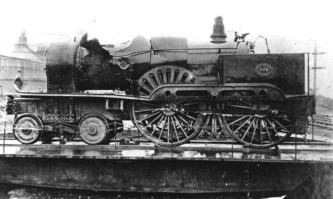It was known as the Diver after leading its doomed train on to the Tay Bridge in 1879 never to reach the other side.
North British Railway (NBR) Engine 224 was eventually brought to the surface and 135 years ago it was sent to Cowlairs under its own wheels for repairs before returning to service.
An unusual fact about the Tay Bridge Disaster is that the locomotive once again crossed the Tay before it was withdrawn in 1919.
Engine 224 was spare in Dundee when it was called out to work a mail train to Burntisland on December 28 1879 after the regular engine from Ladybank failed.
The southbound crossing went without issue but disaster struck on the return journey which was due to arrive at Dundee a little before 7.30pm.
Shortly after 7.13pm the Tay Bridge collapsed but driver David Mitchell and ‘stoker’ John Marshall had no warning of the impending disaster.
The original crossing had been the longest railway bridge in the world but during the storm the wind was said to have blown the iron girders in the central section away “like matchwood”.
Fifty-nine people are known to have died, although there was confusion over the numbers killed as many bodies were not discovered for months.
The locomotive, North British Railway (NBR) 224 built by Thomas Wheatley at Cowlairs Works, survived the disaster.
Despite the fall, the locomotive had been protected by the bridge girders which formed a cage around the train as they fell together.
In April 1880, an attempt to recover it failed when the chains broke and two days later a second attempt also failed because the salvage equipment broke after the locomotive had been brought to the surface.
One week later, it was recovered, and stood on the bank of the Tay until it was sent to Cowlairs on its own wheels for repairs, after which it was returned to traffic.
The first person to drive the Diver was Robert Marshall whose brother, John, 24, had been the fireman on the fateful night.
A new double-track bridge was designed by William Henry Barlow and built by William Arrol & Co, 18 metres upstream of, and parallel to, the original bridge.
The foundation stone was laid on July 6 1883 and the second bridge opened on June 20 1887 and remains in use.
Train drivers became reluctant to take the train across the new Tay Bridge believing it to be unlucky or a bad omen.
However, on the 29th anniversary of the disaster, the engine was used to serve the exact same route as it had that fateful night making the crossing to Dundee across the new Tay Bridge.
The Diver was in service until 1919.
